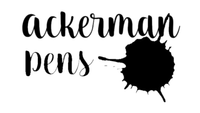About Feeds
The feed is arguably the most important part in a fountain pen. True, the nib is the business end that lays down your drawn line, but if the feed doesn't feed ink to the nib correctly, it doesn't matter what nib you're using.
We've produced a variety of feeds over the years in our search for what works best with popular nibs. All our current feeds can be divided into two categories:
Large Nib Feeds
We've produced large feed for the past ten years using several different configurations. These feeds fit directly into our Fountain Pens and Pump Pens and provide three different flow rates.- Standard: works with thinner inks, such as Noodlers
- Rich: works with thicker inks, such as traditional India ink and Golden Hi-Flow acrylic.
- Full: works with the thickest inks and paints
We can't predict with certainty which feed will work best for you because many variables control the flow rate of ink through a pen. The most important factor is the type of ink you use, which can vary in viscosity and surface tension - the two principal variables that determine flow rate.
You can usually insert and remove these feeds by hand. We sell a Nib and Feed tool that lets you remove feeds and nibs when they get stuck, but you can also use a firm rod with the right diameter.
Small Nib Feeds
We've designed are small nib feeds to fit popular nibs that are smaller than our large nibs including:- Gillott 170 nibs
- Gillott 303 nibs
- Gillott 404 nib (a stiffer version of the 303)
- Manga G Nikko nibs
- Manga G Tachikawa nibs
- Principal nibs
These feeds have a simpler surface geometry than our large nib feeds due to the smaller size of the nibs they feed.
There are several problems fitting feeds to smaller nibs. The first problem is the small size of the nib. Matching a feed to a nib is not easy, and the smaller the nib, the more difficult it is to get a good fit.
The second problem is the variable quality of popular dip nibs. The Gillott 303 is a very popular drawing nib and has been for over 150 years. They are made today using the same inexpensive spring steel and similar rough edge dies used in the beginning. You have to juggle the nib and feed to find the "sweet spot" that provides the best feeding. The Principal nib is higher quality, but it is still made from uncoated spring steel that can rust quickly.
These problems are less true with the Tachikawa and Nikko Manga G nibs, that are blanked, stamped and plated using modern industrial processes.
Cheers and Happy Scribbling!
